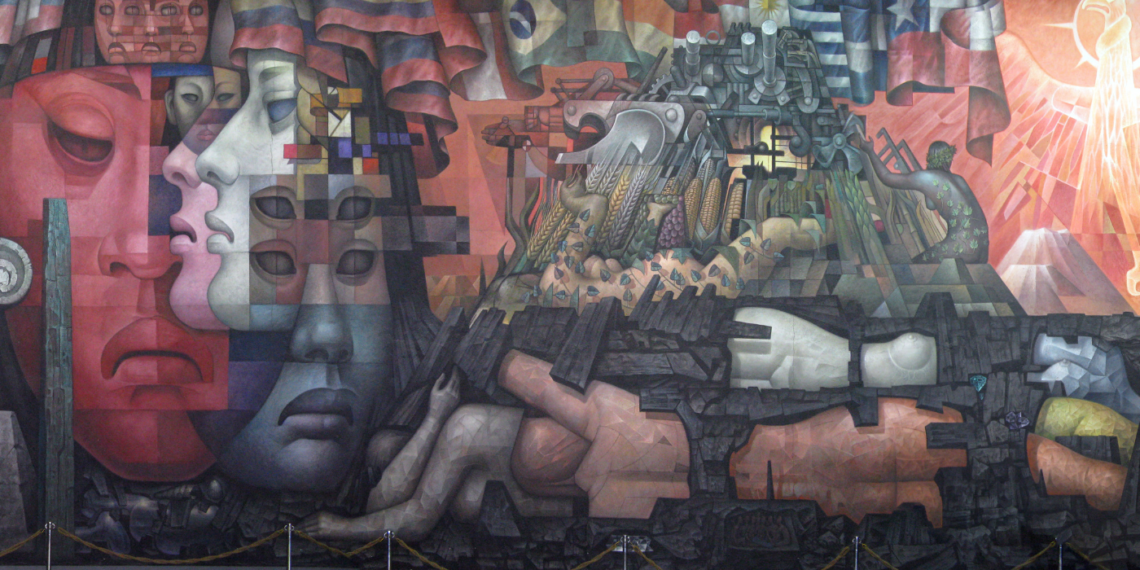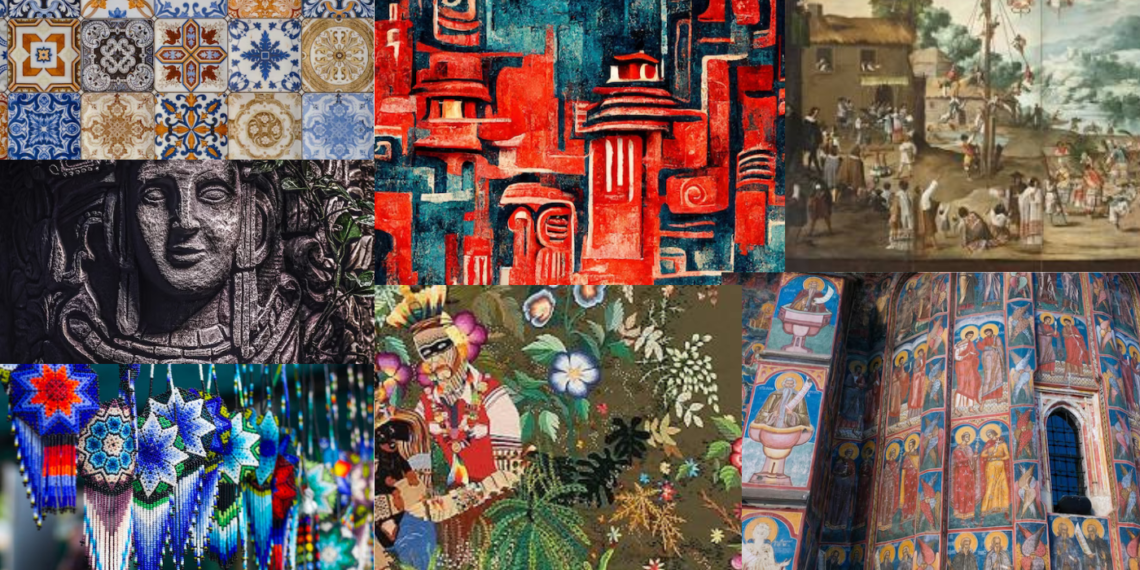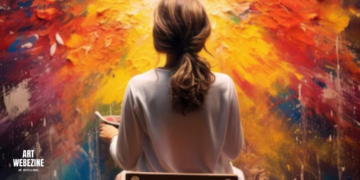Latin America is a treasure trove of artistic diversity, with a tapestry of cultures, histories, and influences that have given birth to a vibrant array of art forms. From the Aztec and Mayan civilizations to the colonial period and contemporary times, Latin American art has been shaped by a rich tapestry of traditions. In this exploration of Latin American art forms, we will journey through the top 7, celebrating the creativity and cultural significance that defines this region’s artistic legacy. From the rhythmic beats of samba to the intricate craftsmanship of Alebrijes, join us on a journey through Latin American art forms that showcase the heart and soul of this dynamic part of the world.

Origins of Latin American Art Appreciation: A Historical Perspective
The appreciation of Latin American art and its history began as a nationalist effort in the second half of the 19th century, partly inspired by independence movements in the country. Initially, discussions of the visual arts were written by learned amateurs, often priests, architects, or foreigners, who often described important monuments in romantic, nontechnical terms. These writers often had knowledge of European monuments that inspired works in Latin American countries.
The secularization of church property in countries like Mexico led to the loss of some constructions and their contents, making documentation important. National institutes for the study of the arts were established in Latin America in the 1930s as part of governments or major universities. Latin American scholars from this period focused on their own visual history, rarely examining it in relation to other countries.
Is Latin America a rich country? Latin America is a region of diverse economies, with some countries being considered rich while others are considered poor. According to the World Bank, the region’s richest country is Chile, followed by Mexico, Brazil, and Argentina. These countries have high levels of GDP per capita, strong infrastructure, and well-developed industries. However, there are also many countries in Latin America that are considered to be poor, such as Haiti, Guatemala, and Honduras. These countries have low levels of GDP per capita, weak infrastructure, and limited economic opportunities.
What Art Forms are Well Known in Latin America?
Latin America is a melting pot of cultural diversity, with various art forms such as muralism, samba, tango, folk art, alebrijes, cumbia, literature, capoeira, ballet folklórico, and lucha libre. Muralism, popularized by artists like Diego Rivera and David Alfaro Siqueiros, is a public art form that often depicts social and political themes. Samba, a dance form, is a key element of Brazilian culture, especially during Carnaval.
Tango, originating in Argentina, is a passionate dance form with dramatic and sensual movements. Folk art, including handmade textiles, ceramics, masks, and crafts, often reflects the region’s cultural and indigenous heritage. Alebrijes are colorful Mexican sculptures with intricate details. Cumbia, a popular music and dance style combining indigenous, African, and Spanish influences, has spread throughout Latin America. Literature, including magical realism, is a notable literary style from the region. Capoeira, a Brazilian martial art, combines dance, acrobatics, and music. Ballet Folklórico showcases traditional Mexican dance and costumes.
Latin America has a rich tradition of art, with famous artists like Frida Kahlo, Diego Rivera, and Pablo Picasso. The art is characterized by bright colors, bold patterns, and religious imagery. Popular art forms include painting, sculpture, music, literature, and film. Famous Latin American artists include Frida Kahlo, Diego Rivera, and Pablo Picasso. Music, including salsa, samba, and tango, is a vital part of Latin American culture. Literary figures like Gabriel García Márquez, Mario Vargas Llosa, and Isabel Allende are also prominent. Latin America’s growing film industry includes “Amores Perros” and “City of God.”
These are just a few of the many art forms that have flourished in Latin America over the centuries. Latin American art is a reflection of the region’s rich history, diverse cultures, and vibrant spirit.
What is Latin America Most Famous for?
Latin America is most famous in the art form of Muralism. Muralism, a powerful and socially charged artistic movement, has its roots in Mexico and has left an indelible mark on Latin American art. Artists like Diego Rivera, David Alfaro Siqueiros, and Jose Clemente Orozco, known as the “Big Three” of Mexican muralism, created monumental works that depicted the country’s history, politics, and social issues.
These murals often adorned public buildings, making art accessible to all and conveying powerful messages of national identity, social justice, and cultural heritage. The Mexican muralism movement inspired similar mural movements throughout Latin America, contributing to the region’s reputation as a hub of mural art.
Muralism is not only an art form but also a reflection of the region’s rich history, social struggles, and cultural pride. It continues to be a source of inspiration and a symbol of Latin American art’s commitment to addressing societal issues through creativity and public expression.
7 Best Latin American Art Forms

Latin America has a rich and varied history in art. You’ll see that Latin America has a lot to offer in the way of art.
Pre-Columbian Art in Latin America
Pre-Columbian art in Latin America is some of the oldest art on the continent. The earliest examples were produced by the Olmec civilization of Mexico. This culture is famous for its sculptures depicting the human head (the famous “Head of the Olmec” sculpture is one example).
The Maya of Central America created some of the earliest known rock art in the world. Pre-Columbian Mesoamerican art is even more ancient than the Olmec and Maya, dating back thousands of years to the Olmec and Maya precursors. This Mesoamerican art is notable for its iconography which shows the influence of the Olmec and Maya precursors.
Catholic Art in Latin America
Catholic art in Latin America is most strongly associated with Mexico. This is largely due to Mexico’s history as a Catholic country. However, Catholic art is also present in many other Latin American countries. The Catholic aesthetic is most strongly present in the Catholic sense of religious art. Catholic art often depicts religious scenes like depictions of Jesus Christ, the Holy Mother, or saints.
Catholic art is also often used in church decorations like the more common rosary-decorated statuettes. Other Catholic art traditions include the creation of sacred art depicting saints. This type of art is often used to decorate churches. Latin American Catholic art often uses a style known as “Mestizo” art, which is a fusion of European and Mesoamerican art styles. Mestizo art is most strongly present in Mexico but is sometimes found elsewhere in Latin America.
Folk Art in Latin America
Folk art in Latin America is primarily associated with the region’s indigenous communities. It is also present in the work of some urban communities that often incorporate indigenous themes into their art. Folk art in Latin America is often created using indigenous materials like wood, clay, or indigenous dyes. Indigenous folk art is often inspired by nature, often depicting animals or plants.
Some indigenous folk art also uses symbols or motifs that have religious significance for the community. Some Latin American folk art is also inspired by the cultures of European settlers. This can include an influence from European visual arts, music, or literature.
Modern Art in Latin America
Latin America has a rich modern art tradition, especially in the work of Mexico, Cuba, and Brazil. Modern art in Latin America often combines influences from European art with indigenous art traditions. Important modern artists in Latin America include Frida Kahlo, Diego Rivera, and Pablo Picasso. Modern art in Latin America often shows influences from surrealism, which was a movement that developed in Europe during the early 20th century.
Spanish Colonial Art
Spanish colonial art in Latin America shares many similarities with Spanish art in the Iberian Peninsula. Colonial art often depicts religious scenes, portraits of Catholic rulers, or depictions of the Spanish conquistadors.
Spanish colonial art often uses decorative and figural styles from the Iberian Peninsula. Spanish colonial art often depicts tropical scenes like plants and animals found in the Americas. Tropical scenes are often depicted in the style of “enamels”, a decorative style that originated in Asia.
Contemporary Art in Latin America
Contemporary art in Latin America is most strongly present in Mexico and Brazil. Contemporary Latin American art often explores themes of social justice and political corruption. Important contemporary artists in Latin America include:
Ana Mendez, Judith Scott Olafur Eliasson. Contemporary Latin American art often uses the language of pop art, abstract expressionism, and surrealism. Contemporary artists use imagery from everyday life, often using photographic and digital sources.
Colonial Art in Latin America
Colonial art in Latin America, produced during the Spanish colonial period (16th-19th centuries), is characterized by religious themes, bright colors, and depictions of Spanish conquistadors, Catholic rulers, and indigenous peoples. Religious themes include the Virgin Mary, Jesus Christ, and saints.
Examples include Miguel Cabrera’s “Head of the Virgin of Guadalupe” and Alonso Cano’s “Virgin of Sorrows,” which depict the Virgin Mary mourning the death of her son, Jesus Christ. Colonial art is an essential part of Latin America’s cultural heritage, reflecting the region’s history, religious beliefs, and artistic traditions, and providing insights into the lives of the people who lived during the Spanish colonial period.
In conclusion, Latin America boasts a vibrant and diverse artistic heritage, encompassing a wide variety of art forms that have evolved over centuries. From the intricate sculptures of pre-Columbian civilizations to the vibrant paintings and murals of modern artists, Latin American art continues to inspire, challenge, and enrich our understanding of the world.





